

|
COSTRUZIONI OLEODINAMICHE SALVI S.r.l.
|
|
PRODOTTI: Sgrigliatori e Nastri trasportatori Bar screen and Conveyor belt |



|
Lo sgrigliatore è un dispositivo elettromeccanico in genere automatico che rimuove i detriti accumulati contro una griglia. È un complemento indispensabile nella vasca di carico della condotta forzata della centrale idroelettrica e in tutte le applicazioni in cui va garantito un flusso costante attraverso una griglia.
In genere è azionato da cilindri oleodinamici che muovono un pettine montato su un braccio incernierato ad una estremità. Il pettine che in un primo tempo viene allontanato dalla griglia e calato in acqua fino alla fine corsa, in un secondo momento viene avvicinato alla griglia e risollevato facendolo correre lungo la stessa.
Il pettine è costituito da una serie di denti, che impegnano gli spazi tra le barre che formano la griglia. Lo sgrigliato (ovvero la massa dei detriti) è sollevato fino alla testa della griglia e scaricato in una canaletta o su un nastro evacuatore. Tali sistemi di evacuazione detriti trasportano il materiale sgrigliato in vasche di recupero o container per un facile stoccaggio e trasporto.
Esistono altri tipi di sgrigliatori, montati con strutture semoventi su rotaie, o costituiti da una catena dentata.
|
|
The bar screen is an electromechanical device usually automatic used for removing debris accumulated against a grid. It is a essential complement in the hydroelectric power station and in all applications in which it must be ensured a constant flow through a grid.
It is generally operated by hydraulic cylinders that move a stripper arm mounted on a hinged at one end. The comb that is a first time away from the grid and dropped in water up to end race, it later was approached grilled and raised just run along the same.
The comb is made up of a series of teeth, which engage the spaces between the bars forming the grid. The trash (ie the mass of the debris) is raised up to the head of the grid and downloaded in a conduit or on a conveyor belt.
Such debris evacuation systems transporting the trash into recovery tanks or containers for easy storage and transportation.
There are other types of bar screen, fitted with self-propelled rail facilities, or consisting of a toothed chain. |
|
SGRIGLIATORI A CILINDRI AUTOPORTANTI
Caratterizzato da semplicità costruttiva ed elevata affidabilità |
|
BAR SCREEN TO SELF-SUPPORTING CYLINDERS
Characterized by simple construction and high reliability |
|
SGRIGLIATORI A BRACCIO ARTICOLATO
Robusti ed affidabili che permettono di avere pettini molto larghi con portate elevate. |
|
BAR SCREEN OFF THE CUFF BEEN DIVIDED
Rugged and reliable, which allow for very large combs with high flow rates |
|
SGRIGLIATORI A BRACCIO TELESCOPICO
Consentono di ridurre l’ingombro verticale mantenendo corse del pettine elevate |
|
BAR SCREEN OFF THE CUFF TELESCOPIC
They allow to reduce the vertical encumbrance keeping comb runs high |
|
SGRIGLIATORI A BENNA Consentono corse elevate mantenendo una macchina compatta |
|
BAR SCREEN TO BUCKET
The passes allow high while maintaining a compact machine |
|
SGRIGLIATORI A CATENA Consentono di eliminare gli ingombri fuori dal canale indipendentemente dalla corsa necessaria |
|
BAR SCREEN TO CHAIN
They allow to remove the encumbrances outside the canal independently of the necessary stroke |
|
NASTRI EVACUATORI |
|
The conveyor belt can be equipped with carpet in chain in metal mesh or rubber.
The constructive configurations can be many: Þ Flat conveyor belt; Þ Flat conveyor belt + inclined conveyor belt in two part; Þ Flat conveyor belt + inclined conveyor belt only one part; Þ conveyor belt with swivelling for to ensure an optimal filling of the container |
|
I nastri evacuatori possono essere equipaggiati con tappeto in rete metallica o in gomma.
Le configurazioni costruttive possono essere molteplici: Þ nastro piano; Þ nastro piano + nastro inclinato in 2 pezzi; Þ nastro piano + nastro inclinato in un unico pezzo; Þ nastro con brandeggio per garantire un ottimale riempimento del cassone. |
|
CONVEYOR BELT |
|
CANALE DI FLUITAZIONE
Le canale di fluitazione sfruttano la spinta dell’acqua generata da una pompa per rimuovere i detriti accumulati al suo interno |
|
CONDUIT OF FLUITATION
The conduit of fluitation exploit the thrust of the water generated by a pump to remove accumulated debris inside |
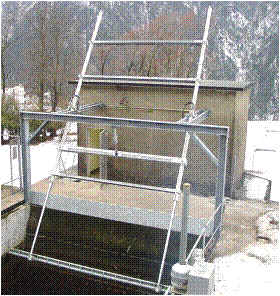
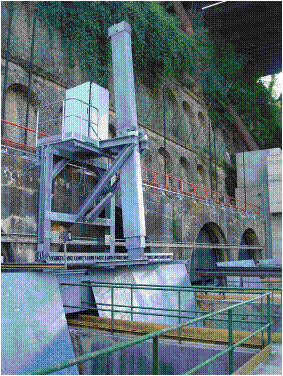
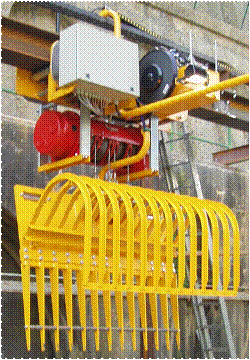
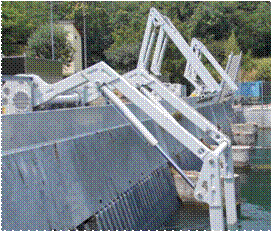
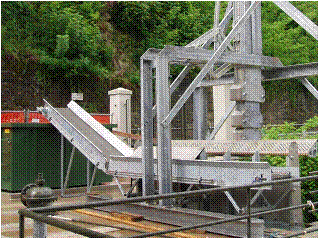
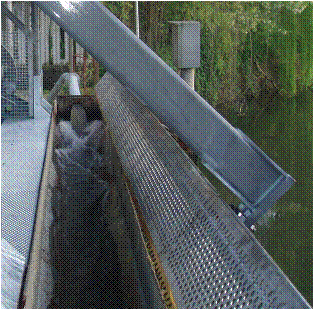
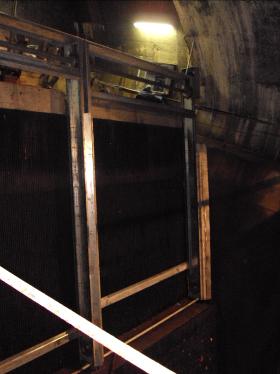
|
Larghezza griglia: Fino a 10 m |
|
Corsa pettine: Fino a 8 m Portata: Fino a 15 q |
|
Postazione: Fissa |
|
Tipologia materiale sgrigliato: Foglie e piccoli arbusti Tronchi di grosse dimensioni |
|
Grid width: Up to 10 m |
|
Stroke comb: Up to 8 m Capacity: Up to 15 q |
|
Position: Fixed |
|
Type of Trash material: Leaves and small shrubs Large-sized trunks |
|
Larghezza griglia: Fino a 11 m |
|
Corsa pettine: Fino a 7 m Portata: Fino a 20 q |
|
Postazione: Fissa o Semovente |
|
Tipologia materiale sgrigliato: Foglie e piccoli arbusti Tronchi di grosse dimensioni |
|
Grid width: Up to 11 m |
|
Stroke comb: Up to 7 m Capacity: Up to 20 q |
|
Position: Fixed or Self-Propelled |
|
Type of Trash material: Leaves and small shrubs Large-sized trunks |
|
Larghezza griglia: Fino a 200 m |
|
Corsa pettine: Fino a 16 m |
|
Numero di sfili: Fino a 3 |
|
Portata: Fino a 20 q |
|
Postazione: Fissa o Semovente |
|
Tipologia materiale sgrigliato: Foglie e piccoli arbusti Tronchi di grosse dimensioni |
|
Grid width: Up to 200 m |
|
Stroke comb: Up to 16 m |
|
Number of extensions: Fino a 3 |
|
Capacity: Up to 20 q |
|
Position: Fixed or Self-Propelled |
|
Type of Trash material: Leaves and small shrubs Large-sized trunks |
|
Larghezza griglia: Fino a 200 m |
|
Corsa benna: Fino a 20 m |
|
Portata: Fino a 15 q |
|
Postazione: Fissa o Semovente |
|
Tipologia materiale sgrigliato: Foglie e piccoli arbusti Tronchi di grosse dimensioni |
|
Grid width: Up to 200 m |
|
Stroke comb: Up to 20 m |
|
Capacity: Up to 15 q |
|
Position: Fixed or Self-Propelled |
|
Type of Trash material: Leaves and small shrubs Large-sized trunks |
|
Larghezza griglia: Fino a 6 m |
|
Corsa pettine: Fino a 20 m |
|
Portata: Fino a 10 q |
|
Postazione: Fissa |
|
Tipologia materiale sgrigliato: Foglie e piccoli arbusti |
|
Grid width: Up to 6 m |
|
Stroke comb: Up to 20 m |
|
Capacity: Up to 10 q |
|
Position: Fixed |
|
Type of Trash material: Leaves and small shrubs |
|
Larghezza tappeto: Fino a 1 m |
|
Lunghezza tratto orizzontale: Fino a 150 m |
|
Larghezza tratto inclinato: Fino a 150 m |
|
inclinazione: 20 ± 5° |
|
Tipologia materiale sgrigliato: Foglie e piccoli arbusti Tronchi di grosse dimensioni |
|
Optional: Brandeggio, inclinazione regolabile |
|
Carpet width: Up to 1 m |
|
Horizontal section length: Up to 150 m |
|
Inclined section width: Up to 150 m |
|
Inclined : 20 ± 5° |
|
Type of Trash material: Leaves and small shrubs Large-sized trunks |
|
Optional: Swiveling, Angle adjustable |
|
Tipologia costruttiva: Lamiera pressopiegata |
|
Larghezza canala: Fino a 1 m Altezza canala: Fino a 1 m |
|
Portata pompa: Fino a 1500 l/min |
|
Postazione: Fissa Tratto finale: Brandeggiante o Telescopico |
|
Tipologia materiale sgrigliato: Foglie e piccoli arbusti |
|
Type of construction: Bent sheet |
|
Conduit width: Up to 1 m Conduit height: Up to 1 m |
|
flow pump: Up to 1500 l/min |
|
Position: Fixed Final section: Swiveling or Telescopic |
|
Type of Trash material: Leaves and small shrubs |